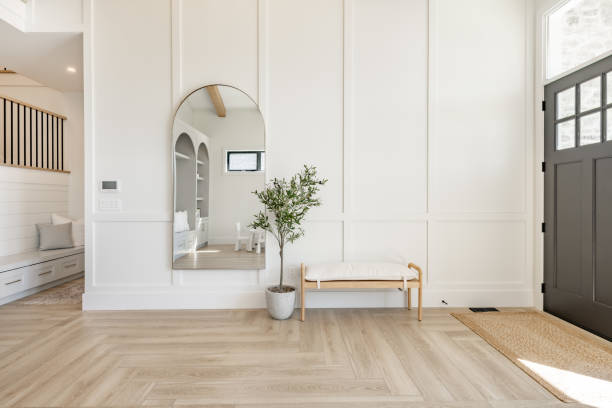Updating a home requires more than picking fresh paint colors or trendy furniture. Every decision should support the way a family lives while reflecting personal taste. Balancing comfort, practicality, and beauty ensures that spaces remain inviting and useful for years. With careful planning, homeowners can create interiors that nurture connection and streamline daily routines.
Creating a Functional Floor Plan
A well-organized layout is the foundation of a comfortable home. Families benefit from open spaces that allow movement without feeling cramped. Clear pathways between rooms and designated zones for specific daily activities help maintain order. Kitchens that flow seamlessly into dining and living areas encourage togetherness, while private nooks offer quiet retreats when needed.
Flexibility also plays an important role. Movable partitions, sliding doors, and multi-use furniture provide options to adapt spaces for different occasions. Parents may need to supervise children while preparing meals, or a dining table might transform into a home office during the day. These design choices allow a family to enjoy both openness and privacy without constant compromises.
Blending Style With Practical Choices
Style should never come at the cost of functionality. Selecting durable surfaces and long-lasting finishes ensures that interiors remain attractive even with daily wear. Choosing materials like wood, stone, or stain-resistant fabrics allows homeowners to enjoy elegance while keeping upkeep simple. Families can still embrace personal taste through color schemes, lighting, and décor accents.
Storage solutions are another way to merge beauty with purpose. Built-in shelving, hidden cabinets, and furniture with concealed compartments reduce clutter while maintaining a clean look. According to Unified Home Remodeling experts, thoughtful design choices can provide homeowners with a balance of style and durability. Their approach shows how families can achieve polished interiors without sacrificing livability. This perspective highlights the importance of aligning your home design goals with everyday demands.
Designing Comfortable Living Areas
Living rooms are often the heart of the home, making comfort a top priority. Furniture should encourage relaxation, conversation, and flexibility for both family nights and gatherings with guests. Sectional sofas, cozy armchairs, and layered lighting help create a warm atmosphere. Proper spacing between pieces keeps the room open and easy to navigate.
Texture adds another dimension to comfort. Soft rugs, plush cushions, and breathable fabrics invite family members to unwind. Lighting placement also affects the mood, with dimmable fixtures supporting different activities throughout the day. Creating a balance between aesthetics and coziness ensures that these shared areas remain welcoming in every season.
Building Family-Friendly Kitchens
Kitchens serve as both functional hubs and social centers. Families benefit from layouts that allow multiple people to work together without congestion. Islands with seating extend the space for meals, homework, or casual conversations. Ample counter space and efficient storage keep cooking organized and enjoyable.
Durability is critical in this part of the home. Choosing surfaces that withstand spills, scratches, and frequent use prevents stress during busy routines. Proper ventilation, bright task lighting, and easy-to-clean flooring contribute to a practical design. When a kitchen blends efficiency with comfort, it naturally becomes a place where family bonds strengthen.
Creating Bedrooms That Promote Rest
Bedrooms should support relaxation and healthy sleep. Soft lighting, soothing color palettes, and comfortable bedding all contribute to a calming environment. Positioning beds away from high-traffic areas helps minimize noise and interruptions. Personal touches, such as framed photos or favorite artwork, allow family members to feel grounded in their space.
Smart storage plays a role here as well. Closets with built-in organizers and under-bed compartments reduce clutter, leaving the room open and peaceful. Children benefit from furniture scaled to their size, giving them independence while maintaining harmony in the overall design. These thoughtful details transform bedrooms into true sanctuaries.
Upgrading Bathrooms for Everyday Ease
Bathrooms may be smaller than other rooms, but they still deserve thoughtful design. Double sinks reduce morning conflicts, while walk-in showers provide convenience for busy households. Choosing slip-resistant flooring and easy-clean surfaces simplifies maintenance while improving safety.
Storage remains vital in these spaces. Medicine cabinets, built-in shelving, and vanity drawers keep toiletries neatly arranged. Adequate lighting above mirrors supports grooming tasks, while softer fixtures create a spa-like feel for relaxation. When bathrooms combine practicality with comfort, they enhance daily routines while supporting long-term value.
Balancing function, style, and family comfort transforms an ordinary house into a supportive environment where people feel at ease. Thoughtful design choices ensure that every room works for both daily living and long-term enjoyment. Families who focus on practical layouts, durable materials, and inviting details create homes that serve both beauty and comfort with equal care.
Published by HOLR Magazine.




